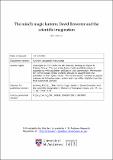The mind's magic lantern : David Brewster and the scientific imagination
Abstract
The imagination has always been thought to operate primarily in conjunction with the sense of vision, imagined objects and scenes being conjured up before the ‘mind’s eye’. In early nineteenth-century Scotland the natural philosopher David Brewster developed a theory of the imagination that explained its operation through a reversal of the normal processes of visual perception. These ideas were rooted in the mental philosophy of the eighteenth-century Scottish Enlightenment. For Brewster the mind’s eye was also the eye of the body, and images from the memory and imagination were projected onto the retina in the same manner that images were projected onto the screen in a magic lantern show. This theory underpinned his belief that imagination played an essential role in scientific discovery. Brewster believed that this process was as essential to the discoveries of science as it was to the creation of great poetry. The writings of Brewster can tell us a great deal about the connections between science and literature in the early nineteenth century, as well as showing that the philosophy of science in contemporary Britain was far from monolithic.
Citation
Jenkins , B 2021 , ' The mind's magic lantern : David Brewster and the scientific imagination ' , History of European Ideas , vol. 47 , no. 7 , pp. 1094-1108 . https://doi.org/10.1080/01916599.2021.1883091
Publication
History of European Ideas
Status
Peer reviewed
ISSN
0191-6599Type
Journal article
Description
This work was supported by the Leverhulme Trust [grant number RPG-2018-017].Collections
Items in the St Andrews Research Repository are protected by copyright, with all rights reserved, unless otherwise indicated.

